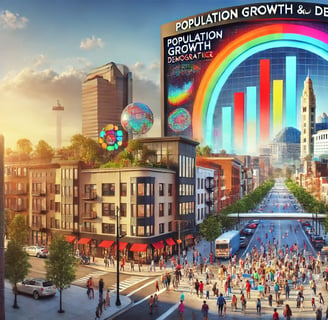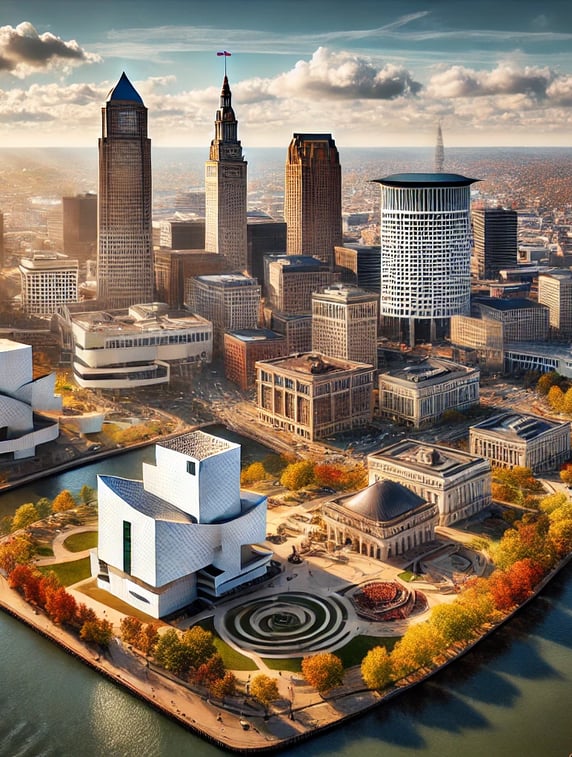
The Future of Cleveland's Real Estate Market: Predictions and Insights
Explore the future of Cleveland's real estate market with key predictions and insights. Learn about growth areas, market challenges, and investment opportunities.
ECONOMIC TRENDSCLEVELANDCUYAHOGA COUNTY
George
8/16/202411 min read
Cleveland’s real estate market is at a pivotal point, shaped by various economic, social, and technological factors. As the city continues to evolve, understanding these trends is essential for buyers, sellers, and investors who want to make informed decisions. Whether it’s the revitalization of urban neighborhoods or the growth of suburban areas, the future of Cleveland’s real estate market holds both opportunities and challenges. By staying informed about these developments, stakeholders can better navigate the market and maximize their investments.
The Future of Cleveland's Real Estate Market: Predictions and Insights


Key Takeaways
Cleveland's real estate market is undergoing significant changes, with a focus on revitalization, affordability, and sustainability. Urban areas like Ohio City and Tremont are seeing renewed interest due to revitalization efforts, while suburban expansion continues to shape the dynamics of the housing market. Predictions for the future suggest a mixed outlook, with growth expected in certain neighborhoods and potential challenges arising from economic and demographic shifts. Understanding these trends will be crucial for anyone involved in the Cleveland real estate market.
Revitalization of Urban Neighborhoods in Cleveland
Cleveland's urban neighborhoods have been at the heart of a significant revitalization effort over the past decade. Areas like Ohio City and Tremont, once known for their industrial roots and periods of decline, have become focal points for new development and cultural resurgence. These neighborhoods are now home to an array of restaurants, breweries, and cultural institutions that attract both residents and tourists, driving up property values and reshaping the local real estate landscape.
In Ohio City, the transformation has been particularly striking. The neighborhood’s proximity to downtown Cleveland, along with the redevelopment of the West 25th Street corridor, has spurred a wave of new housing projects, including modern apartments, townhouses, and renovated historic homes. This influx of development has significantly increased property values, making Ohio City one of the most desirable neighborhoods in Cleveland. However, with gentrification comes challenges, particularly concerning affordability and displacement of long-time residents.
Tremont, another neighborhood experiencing revitalization, has leveraged its artistic and historic character to attract new residents. The conversion of old industrial spaces into lofts, combined with the neighborhood's thriving arts scene, has made Tremont a popular destination for young professionals and creative individuals. As property values rise, the community faces similar challenges to those in Ohio City, balancing growth with the need to preserve its unique identity and affordability.
These revitalization efforts have had a profound impact on Cleveland’s real estate market, particularly in urban areas. As these neighborhoods continue to evolve, they are likely to remain hotspots for real estate activity, attracting both residential and commercial investments.
Revitalization of Urban Neighborhoods in Cleveland
Suburban Expansion and Its Influence
While urban revitalization has garnered significant attention, Cleveland’s suburbs continue to play a crucial role in the region’s real estate market. Suburbs like Solon, Westlake, and Avon have seen steady growth, driven by a combination of factors including strong school systems, safer environments, and a preference for larger homes and more open spaces. This suburban expansion has not only shaped the dynamics of the local real estate market but also created a distinct contrast with the trends seen in urban neighborhoods.
In areas like Solon, the demand for homes remains high due to its top-rated school district and family-friendly amenities. The availability of newer housing developments, coupled with access to parks, shopping centers, and recreational facilities, makes suburbs like Solon particularly attractive to families and professionals who prioritize space and quality of life.
Westlake, another suburban area experiencing growth, offers a blend of suburban comfort and modern amenities, including shopping centers like Crocker Park. The presence of well-maintained parks and highly regarded schools continues to draw new residents, contributing to the steady increase in property values.
However, suburban expansion comes with its own set of challenges. As more people move to the suburbs, issues such as traffic congestion, infrastructure strain, and environmental concerns become more pressing. Additionally, the preference for suburban living has led to a widening gap between urban and suburban real estate markets, with suburban areas generally seeing higher price stability compared to their urban counterparts.
Overall, suburban expansion is expected to continue influencing Cleveland’s real estate market, offering opportunities for growth while also necessitating careful planning to address the challenges that come with it.


Demographic Shifts and Their Impact
Demographic changes are having a significant impact on Cleveland’s real estate market, influencing demand, pricing, and the types of properties that are most sought after. One of the most notable trends is the shifting age distribution, with Cleveland seeing an increase in both younger professionals and older retirees, each with distinct housing preferences.
Younger professionals are often drawn to the revitalized urban neighborhoods, seeking out apartments, lofts, and townhouses that offer proximity to work, entertainment, and cultural activities. This demographic tends to prioritize convenience and lifestyle amenities, which has driven demand in areas like Ohio City and Tremont. On the other hand, retirees are more likely to seek out suburban or quieter urban areas that offer a slower pace of life, access to healthcare, and lower maintenance homes, such as condominiums or single-story houses.
Income levels also play a crucial role in shaping the market. While there is strong demand for luxury properties in both urban and suburban areas, there is also a significant need for affordable housing. Cleveland's population decline in certain areas, combined with the rise of gentrification in others, has created a complex market where both high-end and affordable housing are critical.
Migration patterns further influence the real estate market, with some residents moving to Cleveland for its affordability and quality of life, while others leave for job opportunities in other cities. These shifts impact the demand for different types of housing and are key factors to watch in predicting future market trends.






Expected Growth in Emerging Neighborhoods
Cleveland is home to several neighborhoods that are expected to see significant growth in the coming years, driven by new developments, infrastructure improvements, and increased interest from both residents and investors. Areas such as Detroit-Shoreway, Collinwood, and Glenville are at the forefront of this anticipated growth.
Detroit-Shoreway, located on the west side of Cleveland, has been the focus of extensive redevelopment efforts, particularly around the Gordon Square Arts District. This neighborhood, known for its cultural attractions and vibrant arts scene, is attracting new residents and businesses alike. With ongoing investments in housing and infrastructure, Detroit-Shoreway is poised to become one of Cleveland’s next real estate hotspots, with property values expected to rise as the area continues to develop.
Collinwood, especially North Collinwood, is another neighborhood with strong growth potential. Known for its creative community and proximity to Lake Erie, Collinwood has benefited from several community-driven development projects aimed at enhancing the neighborhood’s appeal. As these projects come to fruition, Collinwood is likely to see increased demand from both homebuyers and investors, further driving property values.
Glenville, a historically significant neighborhood on Cleveland’s east side, is undergoing a transformation fueled by revitalization initiatives such as the Cleveland Foundation’s Glenville Arts Campus. These efforts are aimed at preserving the neighborhood’s cultural heritage while attracting new development. As Glenville continues to evolve, it is expected to become a sought-after area for real estate, with growth driven by both residential and commercial investments.
These emerging neighborhoods represent significant opportunities for those looking to invest in Cleveland’s real estate market. With the right timing and strategy, investors can capitalize on the growth potential in these areas, while homebuyers can find properties that offer both value and long-term appreciation.
Challenges Facing the Market
Despite the positive trends and growth potential in Cleveland’s real estate market, several challenges could impact its future stability. Economic uncertainty, demographic shifts, and the ongoing need for affordable housing are among the most pressing issues.
Economic factors, including fluctuations in the job market and broader economic conditions, can significantly influence the real estate market. Cleveland, like many other cities in the Rust Belt, faces challenges related to economic diversification and job creation. While there have been strides in attracting new industries, particularly in healthcare and technology, the city remains vulnerable to economic downturns, which could affect property values and market confidence.
Demographic changes, including population decline and aging, also present challenges. As Cleveland’s population continues to shrink, particularly among younger residents, there may be reduced demand for certain types of properties. Additionally, an aging population may lead to increased demand for smaller, more accessible homes, which could shift market dynamics.
Affordable housing remains a critical issue in Cleveland, particularly in the wake of gentrification in urban neighborhoods. As property values rise, there is a growing need to ensure that affordable housing options remain available for all residents. Addressing this challenge will be key to maintaining a balanced and inclusive real estate market.




Emerging Neighborhoods Growth in Cleveland
The Role of Technology and Innovation
Technology and innovation are expected to play a pivotal role in shaping the future of Cleveland’s real estate market, influencing everything from property transactions to home management. The adoption of digital tools and platforms is transforming the way real estate is bought and sold, offering new opportunities for both buyers and sellers.
One of the most significant technological trends in real estate is the rise of smart homes. As more homes in Cleveland are outfitted with smart technology—such as automated lighting, security systems, and energy management—buyers are increasingly looking for properties that offer these features. Smart homes not only provide convenience but also enhance property value, making them an attractive option in a competitive market.
Digital marketing and online platforms are also revolutionizing real estate transactions. Virtual tours, online listings, and digital closing processes have become standard practice, especially in the wake of the COVID-19 pandemic. These tools make it easier for buyers to explore properties and complete transactions, even from a distance. As technology continues to evolve, it will become an even more integral part of Cleveland’s real estate market.




Opportunities for Real Estate Investors in Cleveland
For real estate investors, Cleveland offers a range of opportunities across both residential and commercial sectors. The city’s affordable property prices, combined with its ongoing revitalization efforts, make it an attractive market for investment.
In the residential sector, emerging neighborhoods like Detroit-Shoreway and Collinwood offer significant potential for appreciation. Investors who purchase properties in these areas stand to benefit from rising property values as these areas continue to develop. Additionally, the demand for rental properties remains strong, particularly in neighborhoods undergoing revitalization, offering investors steady rental income.
Commercial real estate in Cleveland also presents opportunities, particularly in the downtown area and growing suburban markets. As businesses return to in-person operations and the economy continues to recover, demand for office and retail spaces is expected to increase. Investors who identify high-potential commercial properties in key locations can capitalize on this growth.
Long-term investment strategies in Cleveland should focus on identifying emerging neighborhoods, monitoring demographic trends, and staying informed about economic developments. By taking a strategic approach, investors can maximize their returns and contribute to the city’s ongoing growth.
Opportunities for Real Estate Investors
Advice for Homebuyers
For homebuyers in Cleveland, the next few years will present both opportunities and challenges. As the market continues to evolve, it’s important to stay informed about neighborhood growth potential and future developments.
When considering a home purchase, buyers should focus on neighborhoods that are poised for growth, such as Detroit-Shoreway, Glenville, or Collinwood. These areas offer the potential for property value appreciation as revitalization efforts progress. Additionally, buyers should consider the long-term prospects of the area, including planned infrastructure improvements and community development projects.
It’s also important for buyers to be mindful of their budget and financial situation. While Cleveland remains an affordable market, rising property values in certain neighborhoods may push prices higher. Buyers should ensure they are financially prepared for both the initial purchase and ongoing homeownership costs.




Guidance for Sellers
For sellers in Cleveland, timing is key to maximizing property value. As the market continues to change, understanding when to sell can make a significant difference in the final sale price.
Sellers should pay close attention to market trends in their specific neighborhood. If property values are rising rapidly, it may be advantageous to sell sooner rather than later. Conversely, if the market is showing signs of slowing, holding onto the property for a longer period could yield better results.
Marketing strategies are also crucial for sellers. In today’s digital age, utilizing online platforms and virtual tours can significantly increase a property’s visibility and attract potential buyers. Sellers should work with real estate professionals who are well-versed in the latest marketing techniques to ensure their property stands out in a competitive market.


Financial Planning for First-Time Buyers
Financial planning is crucial for first-time buyers looking to navigate the complexities of homeownership. Beyond the initial purchase price, it’s important to consider long-term costs such as property taxes, maintenance, and potential renovations. Budgeting for these expenses ensures that buyers can sustain their investment without compromising their financial stability.
Securing financing is often the first step in the home buying process. In Cleveland, first-time buyers may have access to various government programs and grants designed to assist with down payments and closing costs. Understanding these options and working with a knowledgeable mortgage advisor can help buyers make informed decisions and secure favorable terms.
Financial Planning for First-Time Buyers
How to Choose the Right Neighborhood
Choosing the right neighborhood involves more than just finding an affordable home. Proximity to work, schools, and amenities are all critical factors that can impact daily life. Additionally, the community vibe and future development plans should be considered, as these can affect both the quality of life and the long-term value of the property.
For first-time buyers, it’s important to research each neighborhood thoroughly, visit potential homes at different times of day, and talk to current residents to get a feel for the community. By weighing these factors, buyers can select a neighborhood that aligns with their lifestyle and long-term goals.




Cleveland’s real estate market is at a pivotal moment, with significant opportunities for growth and development. As the city continues to evolve, staying informed about market trends and predictions will be essential for making successful real estate decisions. Whether you are a buyer, seller, or investor, understanding the factors shaping Cleveland’s real estate market will help you navigate this dynamic landscape with confidence.
Frequently asked questions
What are the most promising neighborhoods for investment in Cleveland?
Emerging neighborhoods like Detroit-Shoreway, Collinwood, and Glenville are expected to see significant growth, making them promising areas for real estate investment.
How will Cleveland’s real estate market be affected by economic changes?
Economic factors, including job market fluctuations and broader economic conditions, can influence property values and market stability. Cleveland's ongoing efforts to diversify its economy will be key to mitigating these impacts.
Is it a good time to buy or sell property in Cleveland?
The decision to buy or sell should be based on specific market conditions in your neighborhood. Buyers should look for areas with growth potential, while sellers should consider timing and market trends to maximize their property value.
Related Posts







